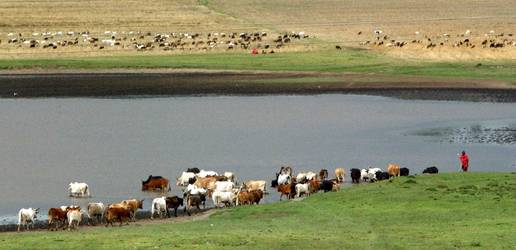GLEAM model in brief
GLEAM is a modelling framework that simulates the interaction of activities and processes involved in livestock production and the environment. The model can operate at (sub) national, regional and global scale.
GLEAM differentiates key stages along livestock supply chains such as feed production, processing and transport; herd dynamics, animal feeding and manure management; and animal products processing and transport. The model captures the specific impacts of each stage, offering a comprehensive and disaggregated picture of livestock production and its use of natural resources.
Features
GLEAM is designed to analyze multiple environmental dimensions, such as feed use, greenhouse gas emissions, land use and land degradation, nutrient and water use and interaction with biodiversity. The main features of the current version of GLEAM are:
- Systematic, global coverage of six livestock species and their edible products: meat and milk from cattle, buffalo, sheep and goats; meat from pigs and meat and eggs from chicken.
- Spatially explicit modelling of livestock distribution, climatic data, feed yields and biophysical processes that allows the capture of local production drivers and/or constraints, environmental impacts and identification of intervention measures.
- Estimation of greenhouse gas emissions from each stage of production. The model covers emissions of methane (CH4), carbon dioxide (CO2) and nitrous oxide (N2O), using an IPCC Tier 2 methodology, providing more accurate information on how animal feeding, herd and manure management options can help in mitigation.
- Can be used to run scenarios of interventions in the livestock sector and can be coupled with other models (e.g. grassland models for sequestration, economic data for cost of mitigation etc.)
Outputs
A complete simulation of GLEAM produces multiple outputs which can be either final indicators and maps or intermediate calculations for subsequent operations. In its current version, GLEAM 3.0 outputs include:
- livestock animal numbers, production systems and their spatial distribution;
- production of manure and its management;
- feed intake and animal feed rations composition and quality;
- land use associated with feed intake;
- production of livestock commodities;
- GHG emissions arising from each stage of production;
- nitrogen used at each stage of production
Spatial resolution
GLEAM is intended to assess the global livestock sector. Many of the processes involved in livestock production, however, occur at small scales and are driven by (sub)-national or local environmental and social conditions. Thus, global averages and indicators are usually misleading and do not adequately help the understanding of real problems and how to tackle them.
To capture this variability, GLEAM uses regional or (sub)-national information on production practices and animal parameters. Additional data on livestock numbers, pasture and feed availability is incorporated with a resolution not coarser than 5 arc minutes (circa 10 x 10km at the equator). This is the same spatial resolution at which GLEAM produces the outputs.

